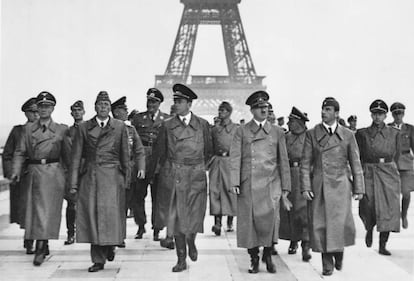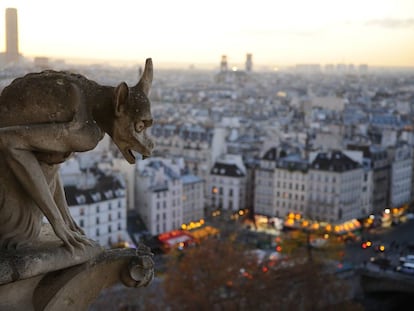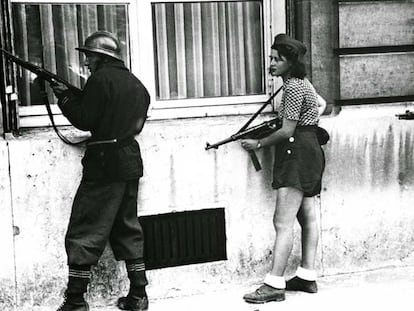Is Paris burning?
Hitler would dance for joy at the sight of Notre-Dame going up in flames so many years later

¡°Is Paris burning?¡± screamed Hitler hysterically into the telephone in August 1944, addressing General Von Choltitz, the German commander of the occupied French capital. The general disobeyed orders to destroy the city in a move that could have cost him his neck, since Hitler did not take kindly to disobedience.
Unfortunately, the sight of European cathedrals in flames is not new
Dominique Lapierre and Larry Collins turned this sentence into the title of one of their most famous books. Today, Hitler would be dancing for joy, as he did when he conquered France, at the sight of Notre-Dame, the heart of Paris, going up in flames all these years later. It was the Nazi leader¡¯s dream of revenge come true on a terrifying afternoon. And in these times of fascist resurgence.
Many of us shivered to think that Paris was indeed burning, adding to a long series of tragedies in the French capital with the power of imagery worthy of 9/11. The terrible sight of Notre-Dame in flames took us back to the time, over 70 years ago now, when other religious temples burned across Europe during World War II, including the 14th-century Coventry cathedral, destroyed in a savage attack by the Luftwaffe on November 14, 1940 during the Battle of Britain and left in ruins (a modern cathedral was built nearby).
And there was also the cathedral of the Holy Trinity in Dresden (a city considered the Florence of the Baroque period, a fact that did not save it from destruction), which was razed to the ground in the fiery hell unleashed by Allied air bombings in 1945, and later rebuilt. And the cathedral in Cologne, which was badly damaged but did not collapse. And the ones in Warsaw and Rotterdam...there was even the highly symbolic Saint Paul¡¯s cathedral in London, which had its dome perforated by a bomb during the Blitz, but showed off its wounds as a symbol of Londoners¡¯ resistance.
Many of us shivered to think that Paris was indeed burning, adding to a long series of tragedies in the French capital
And that is without forgetting the architectural victims of WWI, when the equally symbolic cathedral of Reims was described as a ¡°martyr¡± after being bombed in premeditated fashion by the Germans. Bombs aside, some parallels can be drawn between the story of this cathedral (which was damaged again during WWII) and what happened to Notre-Dame: scaffolding on the north tower caught fire, propagating the flames throughout the timber frame structure. The lead on the roofing melted and spilled out of the gargoyles in a scene straight out of hell. In a show of piety and patriotism, local residents picked up the lead pieces, which were later used to rebuild the place of worship.
Unfortunately, the sight of European cathedrals in flames is not new. While we may feel overwhelmed by images of Notre-Dame on fire, this has been a regular occurrence throughout contemporary history.
English version by Susana Urra.
Tu suscripci¨®n se est¨¢ usando en otro dispositivo
?Quieres a?adir otro usuario a tu suscripci¨®n?
Si contin¨²as leyendo en este dispositivo, no se podr¨¢ leer en el otro.
FlechaTu suscripci¨®n se est¨¢ usando en otro dispositivo y solo puedes acceder a EL PA?S desde un dispositivo a la vez.
Si quieres compartir tu cuenta, cambia tu suscripci¨®n a la modalidad Premium, as¨ª podr¨¢s a?adir otro usuario. Cada uno acceder¨¢ con su propia cuenta de email, lo que os permitir¨¢ personalizar vuestra experiencia en EL PA?S.
?Tienes una suscripci¨®n de empresa? Accede aqu¨ª para contratar m¨¢s cuentas.
En el caso de no saber qui¨¦n est¨¢ usando tu cuenta, te recomendamos cambiar tu contrase?a aqu¨ª.
Si decides continuar compartiendo tu cuenta, este mensaje se mostrar¨¢ en tu dispositivo y en el de la otra persona que est¨¢ usando tu cuenta de forma indefinida, afectando a tu experiencia de lectura. Puedes consultar aqu¨ª los t¨¦rminos y condiciones de la suscripci¨®n digital.











































